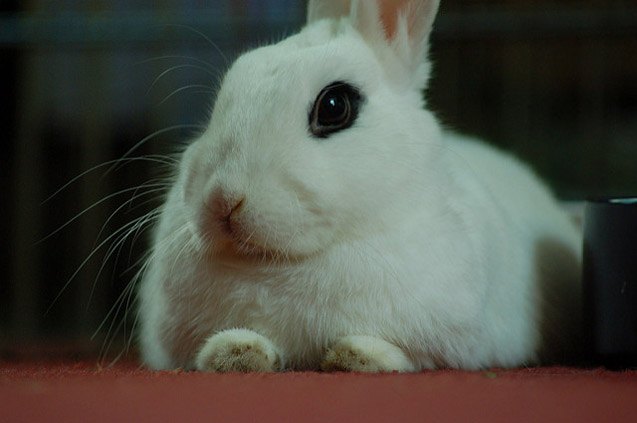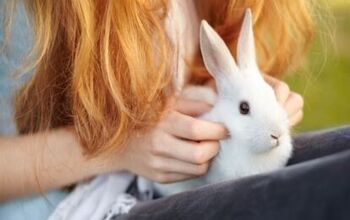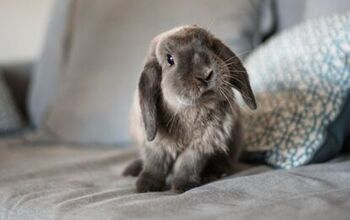Blanc De Hotot Rabbit


About Blanc De Hotot Rabbit
Credit for the Blanc de Hotot Rabbit is given to Eugenie Bernhard, chatelaine du Calvados, who is the second woman in history to develop a new rabbit breed. The breed was developed in Hotot-en-Auge, Normandy, where Bernhard goal was to perfect a new breed for meat and fur in 1902. She crossed a Papillon with a White Vienna, as well as a White Flemish Giant, and worked on this breed for 20 years. After crossing over 500 breeds, it wasn’t until 1920 that she showed the perfected breed to the Exposition international d’Aviculture in Paris.
In October of 1922, the French officially recognized the breed and it was soon exported to the United States, however they did not last long and soon the Blanc de Hotot no longer existed in the US. The Blanc de Hotot was imported to Switzerland, but because of World War II, the rabbit breed nearly vanished in Europe. In 1978, Bob Whitman of Texas imported eight Blanc de Hotots from France and showed them. This rabbit breed was accepted by the American Rabbit Breeder’s Association (ARBA) on March 5, 1979 but is still considered to be a globally endangered breed.
Its sweet disposition makes Blanc de Hotot Rabbit great for families looking to have their first pet.
This rabbit breed has a large, commercial body shape which weighs anywhere from 8-11 lbs., with does weighing more on the heavier side than bucks. Like most rabbits, they have a small tail and have medium-sized ears that stand erect on their heads.
The Blanc de Hotot rabbit has soft, rollback fur that is relatively short, except for the extra-long guard hairs that give the rabbit its frosty sheen. It does not need much maintenance in order to keep it in tip-top shape. Owners and breeders who keep these rabbits as pets, show or fur animals should groom their rabbit with a slicker brush bi-weekly on off-season shedding times and 1-2 times per week when they begin to shed.
Blanc de Hotot rabbits are completely white, its eyes are a dark brown and the only marking they should have is a ring around their eyes resembling eyeliner. The eye bands should not be over an eighth of an inch thick, according to ARBA standards.
For a well-rounded, friendly Blanc de Hotot rabbit, owners need to take their rabbit out of enclosures and play with them.
A well-balanced rabbit diet consists of 70 percent hay, with the remaining 30 percent being leafy greens, fruits, pellets, and vegetables. There are many different kinds of hay available to feed your rabbit, but most owners opt to purchase timothy hay as it has a high percentage of crude protein, calcium and fiber, and is more readily available in stores. Others kinds of acceptable hay to feed your rabbit includes orchard grass, oat hay, meadow hay, or alfalfa. You should also always have water readily available for your rabbit to drink (bottles are preferred to bowls, as bowls can become soiled with food, hay, bedding, etc).
The rabbit enclosure can be indoors or out, weather and temperature permitting. Blanc de Hotots do not do well in extreme heat or cold, so always be aware of outdoor conditions before letting your rabbit spend time outside. Outdoor enclosures need protection from the elements and predators (raised wooden enclosures are preferred), while indoor enclosures should be made of wire and have solid bottoms (plastic or metal). Both indoor and outdoor enclosures need bedding on the bottom that should be spot-cleaned every day to keep it as clean as possible, and completely replaced at the end of each week.
To have a well-rounded, friendly rabbit, owners need to take the time to bring their rabbit out of their enclosures and play with them. Owners cannot expect to have a friendly rabbit without putting in the effort – let them explore their surroundings and giving them plenty of love in the form of cuddling and petting their backs, ears and head. Rabbits who are exposed to these conditions will learn to be sweet, affectionate creatures.
The Blanc de Hotot rabbit is not susceptible to any hereditary diseases, but there are some things owners need to watch for. Overgrown teeth is by far one of the most common problems. This can be prevented with a well-balanced diet consisting mostly of hay. If your rabbit doesn’t seem to be eating, is less energetic and/or has less droppings than usual, their teeth may be growing into their face and/or jaw. To correct overgrown teeth, take your rabbit to your veterinarian where they can shave down the teeth and prescribe antibiotics for any infection.
Those caring for a rabbit should also check their ears periodically (bi-weekly) for any sign of ear mites, as it is also rather common, especially in outdoor rabbits. Flystrike is also another rabbit issue that occurs when flies lay their eggs in a rabbit’s soiled coat (usually on their bottom). When these eggs hatch, their sole source of protein is your rabbit. Lack of appetite, lethargy and/or sudden yelps of agony can be signs of flystrike. Take your rabbit to a veterinarian if you believe it has flystrike, as it could be deadly.
Blanc de Hotots exposed to love and affection will become sweet, affectionate pets.
Be sure to socialize your rabbit as soon as you can, preferably when it is still a young kit. Socializing your Blanc de Hotot Rabbit means taking the time to bring it out of its enclosure, petting it and introducing it to young children and other animals. Because of their docile natures, rabbits tend to do best when they are the only animal in the house, but they are known to be friendly towards other pets (such as dogs) so long as they grow up with them.
Their sweet dispositions make Blanc de Hotots great for families looking to have their first pet as well as for singles, couples or seniors looking for companionship. While they are not known to be overly active, indoor rabbits will enjoy time outside so they can hop about the grass and explore the world around them. Some owners go outside with their rabbits on a leash, as most small dog harnesses fit them perfectly.
When it comes to training, rabbits are known to be harder to train that other animals such as cats, dogs or birds. Having said that, it is not completely impossible to potty train, but it is going to be a challenge. Pet owners need to be armed with plenty of patience, time and treats in order to reward them for good behaviors. Some owners have also found success by placing more than one litter box around the home so their rabbit does not have to go far in order to find the proper place to “go”.
Photo credit: Ketzirah Lesser & Art Drauglis/Flickr

More by Diana Faria

























